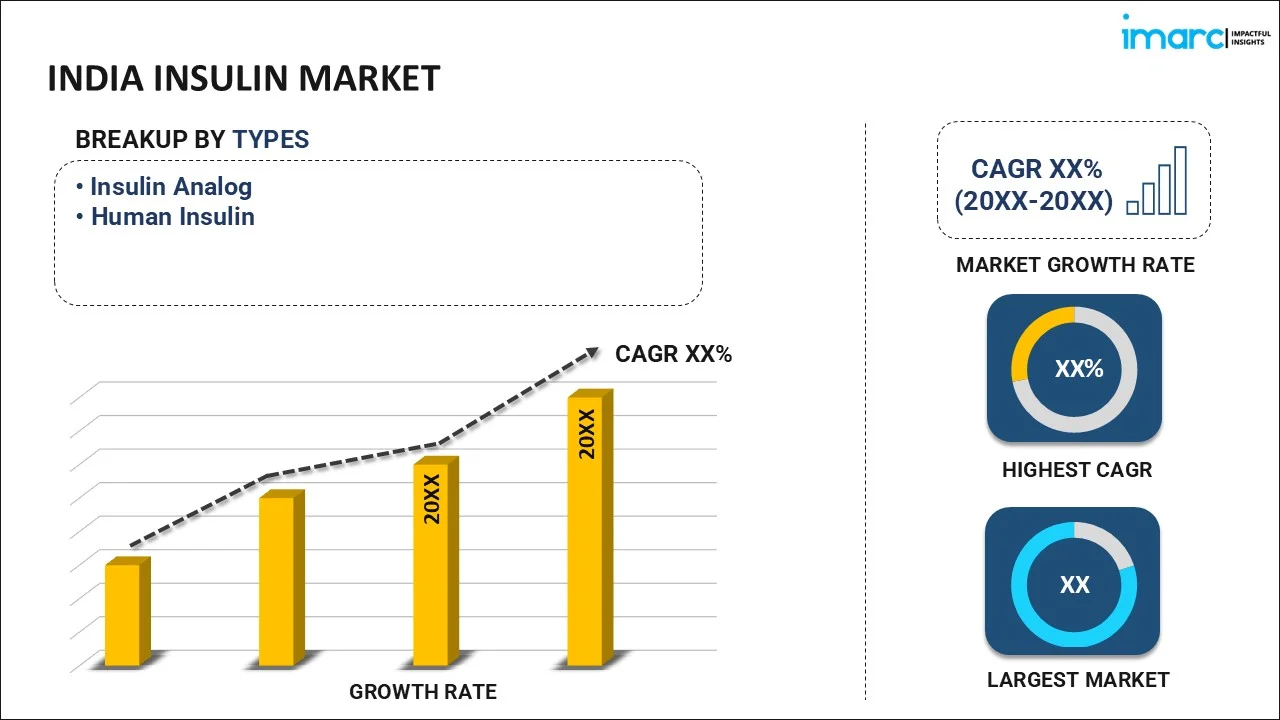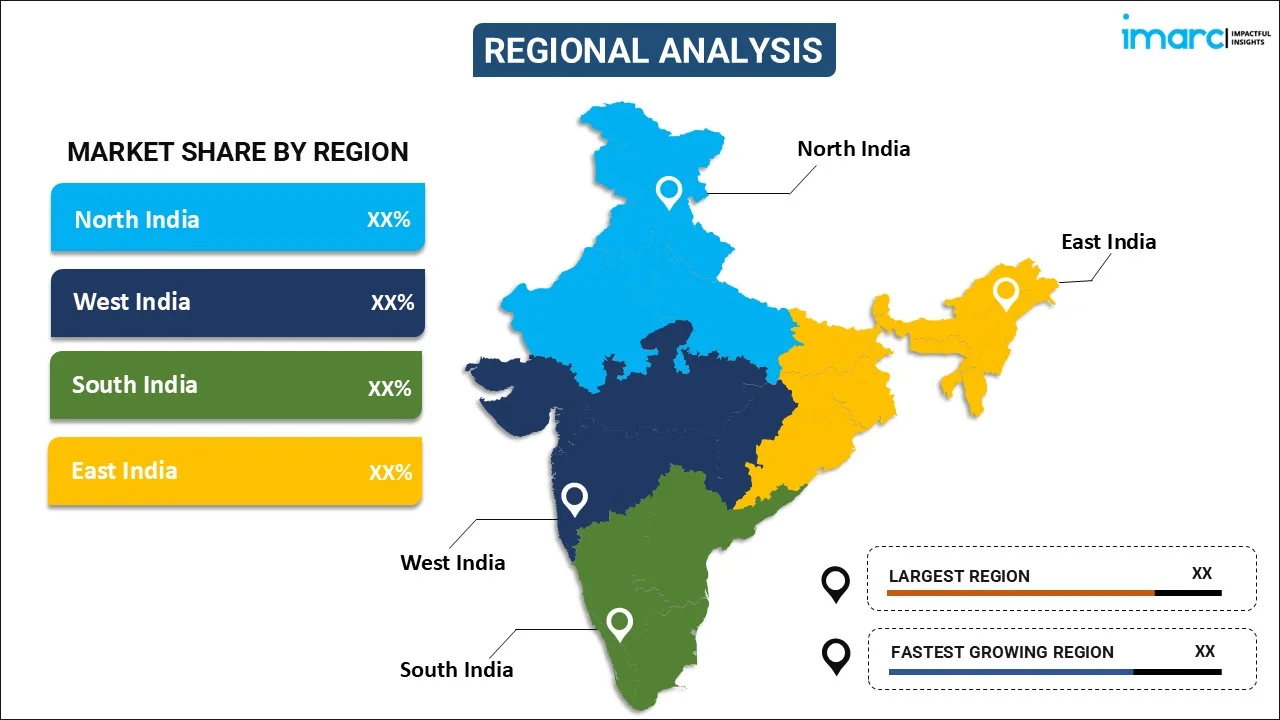
India Insulin Market Size, Share, Trends and Forecast by Type, Application, Product, Distribution Channel, and Region, 2025-2033
India Insulin Market Overview:
The India insulin market size reached USD 635.70 Million in 2024. Looking forward, IMARC Group expects the market to reach USD 897.06 Million by 2033, exhibiting a growth rate (CAGR) of 3.90% during 2025-2033. The market is expanding due to rising diabetes cases, increasing demand for biosimilar insulin and government initiatives to improve affordability. Technological advancements in insulin delivery devices, growing domestic manufacturing and surging online pharmacies and modern retail channels are enhancing accessibility and strengthening the India insulin market share.
|
Report Attribute
|
Key Statistics
|
|---|---|
|
Base Year
|
2024 |
|
Forecast Years
|
2025-2033
|
|
Historical Years
|
2019-2024
|
| Market Size in 2024 | USD 635.70 Million |
| Market Forecast in 2033 | USD 897.06 Million |
| Market Growth Rate (2025-2033) | 3.90% |
India Insulin Market Trends:
Rising Diabetes Prevalence
The prevalence of diabetes in India is rising at an alarming rate driven by sedentary lifestyles, poor dietary habits and genetic predisposition. Urbanization has led to decreased physical activity and increased consumption of processed foods contributing to obesity a major risk factor for Type 2 diabetes. According to data published by the National Library of Medicine, the prevalence of type 2 diabetes (T2DM) in Southern India increased over a 10-year period. In younger individuals (ages 20-39), the prevalence rose from 4.5% to 7.8% while in older individuals (ages 40 and above) it increased from 28.4% to 34%. The incidence of T2DM also saw significant increases rising by 120% in younger participants (from 0.5% to 1.1%) and by 150% in older participants (from 2% to 5%). Stress and irregular sleep patterns further exacerbate insulin resistance. Additionally, Type 1 diabetes cases are growing especially among children and young adults requiring lifelong insulin therapy. The burden on healthcare infrastructure is increasing prompting the government and private sector to enhance diabetes management programs. Awareness campaigns, early screening initiatives and lifestyle interventions are gaining traction to curb the rising numbers. With an expanding patient base and advancements in insulin therapies the demand for affordable and efficient diabetes care solutions continues to grow, shaping the India insulin market outlook.
Government Initiatives & Price Regulations
The Indian government is actively implementing initiatives to make insulin more affordable through price caps, subsidies and healthcare programs. The National Pharmaceutical Pricing Authority (NPPA) regulates insulin prices under the Drug Price Control Order (DPCO) to prevent overpricing by pharmaceutical companies. Additionally, schemes like Ayushman Bharat and Jan Aushadhi Kendras provide low-cost insulin to economically weaker sections. The Pradhan Mantri Bhartiya Janaushadhi Pariyojana (PMBJP) ensures access to affordable generic insulin reducing dependency on expensive brands. According to the report published by the Press Information Bureau, the Government of India supports diabetes treatment through the NP-NCD funding 724 District NCD Clinics and 6,110 Community Health Centre NCD Clinics. Aiming to screen individuals over 30 diabetes affects 10.1 crores in India. Free essential medicines including insulin are available under NHM initiatives and the PMBJP program. Government collaborations with private manufacturers are also promoting domestic insulin production reducing reliance on imports. These efforts are driving wider insulin adoption making treatment more accessible and contributing to India insulin market growth.
India Insulin Market Segmentation:
IMARC Group provides an analysis of the key trends in each segment of the market, along with forecasts at the regional level for 2025-2033. Our report has categorized the market based on type, application, product and distribution channel.
Type Insights:

- Insulin Analog
- Human Insulin
The report has provided a detailed breakup and analysis of the market based on the type. This includes insulin analog and human insulin.
Application Insights:
- Type 1 Diabetes
- Type 2 Diabetes
A detailed breakup and analysis of the market based on the application have also been provided in the report. This includes type 1 diabetes and type 2 diabetes.
Product Insights:
- Rapid-Acting Insulin
- Long-Acting Insulin
- Combination Insulin
- Biosimilar
- Others
A detailed breakup and analysis of the market based on the product have also been provided in the report. This includes rapid-acting insulin, long-acting insulin, combination insulin, biosimilar and others.
Distribution Channel Insights:
- Hospital Pharmacies
- Retail and Specialty Pharmacies
- Others
A detailed breakup and analysis of the market based on the distribution channel have also been provided in the report. This includes hospital pharmacies, retail and specialty pharmacies and others.
Regional Insights:

- North India
- South India
- East India
- West India
The report has also provided a comprehensive analysis of all the major regional markets, which include North India, South India, East India and West India.
Competitive Landscape:
The market research report has also provided a comprehensive analysis of the competitive landscape. Competitive analysis such as market structure, key player positioning, top winning strategies, competitive dashboard, and company evaluation quadrant has been covered in the report. Also, detailed profiles of all major companies have been provided.
India Insulin Market News:
- In December 2024, Cipla Limited received regulatory approval from CDSCO to distribute and market Afrezza in India. This inhaled insulin offers a needle-free option for managing diabetes, acting quickly within 12 minutes. Cipla aims to enhance patient experiences and expand access to innovative treatments for diabetes across the country.
- In December 2023, USV and Biogenomics announced the launch of INSUQUICK India’s first biosimilar Insulin Aspart aimed at enhancing diabetes care. Developed with indigenous technology the product underwent extensive clinical testing. Available in various formats it addresses the needs of the Indians living with diabetes and at risk.
India Insulin Market Report Coverage:
| Report Features | Details |
|---|---|
| Base Year of the Analysis | 2024 |
| Historical Period | 2019-2024 |
| Forecast Period | 2025-2033 |
| Units | Million USD |
| Scope of the Report |
Exploration of Historical Trends and Market Outlook, Industry Catalysts and Challenges, Segment-Wise Historical and Future Market Assessment:
|
| Types Covered | Insulin Analog, Human Insulin |
| Applications Covered | Type 1 Diabetes, Type 2 Diabetes |
| Products Covered | Rapid-Acting Insulin, Long-Acting Insulin, Combination Insulin, Biosimilar, Others |
| Distribution Channels Covered | Hospital Pharmacies, Retail and Specialty Pharmacies, Others |
| Regions Covered | North India, South India, East India, West India |
| Customization Scope | 10% Free Customization |
| Post-Sale Analyst Support | 10-12 Weeks |
| Delivery Format | PDF and Excel through Email (We can also provide the editable version of the report in PPT/Word format on special request) |
Key Questions Answered in This Report:
- How has the India insulin market performed so far and how will it perform in the coming years?
- What is the breakup of the India insulin market on the basis of type?
- What is the breakup of the India insulin market on the basis of application?
- What is the breakup of the India insulin market on the basis of product?
- What is the breakup of the India insulin market on the basis of distribution channel?
- What is the breakup of the India insulin market on the basis of region?
- What are the various stages in the value chain of the India insulin market?
- What are the key driving factors and challenges in the India insulin market?
- What is the structure of the India insulin market and who are the key players?
- What is the degree of competition in the India insulin market?
Key Benefits for Stakeholders:
- IMARC’s industry report offers a comprehensive quantitative analysis of various market segments, historical and current market trends, market forecasts, and dynamics of the India insulin market from 2019-2033.
- The research report provides the latest information on the market drivers, challenges, and opportunities in the India insulin market.
- Porter's five forces analysis assist stakeholders in assessing the impact of new entrants, competitive rivalry, supplier power, buyer power, and the threat of substitution. It helps stakeholders to analyze the level of competition within the India insulin industry and its attractiveness.
- Competitive landscape allows stakeholders to understand their competitive environment and provides an insight into the current positions of key players in the market.
Need more help?
- Speak to our experienced analysts for insights on the current market scenarios.
- Include additional segments and countries to customize the report as per your requirement.
- Gain an unparalleled competitive advantage in your domain by understanding how to utilize the report and positively impacting your operations and revenue.
- For further assistance, please connect with our analysts.
 Inquire Before Buying
Inquire Before Buying
 Speak to an Analyst
Speak to an Analyst
 Request Brochure
Request Brochure
 Request Customization
Request Customization




.webp)




.webp)












